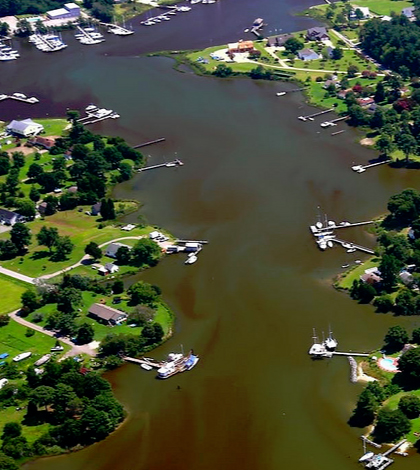Near Chesapeake Bay, VIMS Researchers Study New Algae On The Rise

Algae bloom in and around Perrin Creek, near Chesapeake Bay. (Credit: Wolfgang Vogelbein, Virginia Institute of Marine Science)
In mid-August, scientists at the Virginia Institute of Marine Science measured algae concentrations near the mouth of the York River, which drains into Chesapeake Bay’s western half. One of their measurements hit a high of 200,000 algal cells per milliliter, one of the densest they had ever seen.
The blooms, which carried on through August and continue to occur today, were dominated by Alexandrium monilatum, a type of algae that is relatively new to the area. Scientists at VIMS don’t know as much about the new algae as they’d like to and are dissecting the ways that it reproduces (sexually and asexually), what factors influence its abundance, as well as a beautiful bioluminescence its cells sometimes give off.
Of course, Alexandrium is not the only kind of algae that lives in the area and VIMS researchers note that Cochlodinium polykrikoides is found much more commonly.
“That organism has been in the York River and it blooms pretty regularly,” said Kim Reece, chair of the Department of Aquatic Health Sciences and professor of marine science at VIMS. “But in 2007, we began to see Alexandrium. It has impacts on shellfish and may have impacts on finfish. It turns out that, in the mid-1990s, that Cochlodinium had spread into Chesapeake Bay. It looks like the same sort of pattern may be happening with Alexandrium.”

A dense bloom of the bioluminescent alga Alexandrium monilatum light up the waters of lower Chesapeake Bay during August 2015. (Credit: Susan Maples, Virginia Institute of Marine Science)
With its spread comes new threats to a rebounding shellfish industry in the mid-Atlantic region, Reece says. And that is one reason that she and other scientists at William & Mary are so interested in studying the blooms. So far, they have thrown a lot at the problem, including aerial photography, satellite measurements and field sampling to gather measurements directly from the blooms.
That is in part because studying the blooms is really very complex. Reece says that you can be boating through a section of Alexandrium one second and then be in clearer waters the next. All the wave action in the Bay, influenced a lot by weather changes, is on the list of things researchers want to tackle.
“The conditions this year were quite favorable for an Alexandrium bloom. We want to understand what those are. That’s part of what the Dataflow does,” said Reece. The Dataflow is a ship-mounted suite of sensors that can be run through an ongoing bloom to take measurements on many parameters influencing or relating to the bloom, like temperatures, salinity, pH and chlorophyll levels. “We want to better understand what’s driving the blooms. Clearly the temperatures and nutrients, but we think there are physical patterns at play like wind. They’re very patchy with heavy concentrations shifting quite a bit.”
That is where the satellite and aerial measurements, gathered with help from NASA flyovers and space-fielded instruments, come into play. VIMS researchers are comparing data they’ve collected using the Dataflow and during manual sampling efforts to images of the blooms taken by the NASA tech. These include cameras and hyper spectral sensors.

VIMS professor Kim Reece (left) and graduate student Sarah Pease measure water quality in the York River to explore potential links with bloom characteristics. (Credit: David Malmquist, Virginia Institute of Marine Science)
From that ground-truthing effort, they are then plugging findings into models that relate to water’s movement in Chesapeake Bay. If they can nail down how all the conditions work together, perhaps they can develop useful forecasting tools for those who depend on the Bay for their livelihoods.
“There are watermen and oyster growers all along the Bay. The shellfish industry has been growing in Virginia and the mid-Atlantic region in general,” said Reece. “Blooms have impacts on their animals. We want to inform the public and the aquaculture industry so they can take proper precautionary approaches.”
Some of those could include shutting the water intakes of hatcheries when blooms were abundant, Reece says, adding that the researchers at VIMS commonly employ that technique when they have sensitive study subjects in their labs that need protection.
Officials at the Virginia Department of Health are also very interested in knowing more about these blooms, including how they form, where they’re going and what algae species make them up.
“We hope to be able to use remote sensing to track the blooms. Satellites give us new tools to predict their behavior and it’s much more difficult to chase these blooms around in a boat,” said Reece. “We’d like to be able to do that down the road with the spectral sensing to get a better idea of what is blooming, where it’s blooming and when it’s blooming.”
Top image: Algae bloom in and around Perrin Creek, near Chesapeake Bay. (Credit: Wolfgang Vogelbein, Virginia Institute of Marine Science)




0 comments